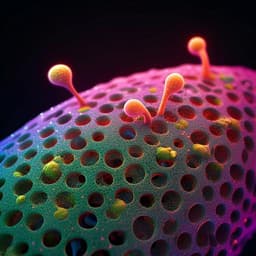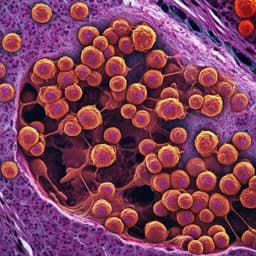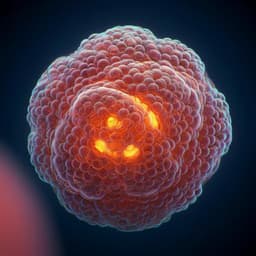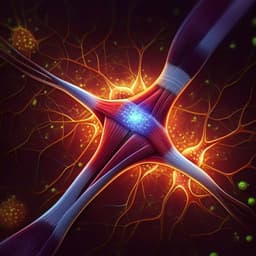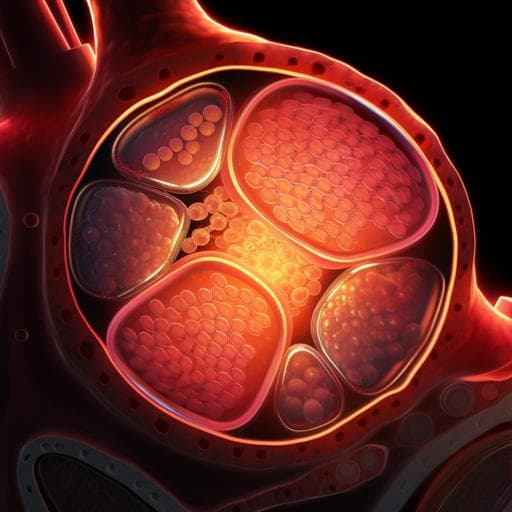
Medicine and Health
Generation and characterization of cardiac valve endothelial-like cells from human pluripotent stem cells
L. Cheng, M. Xie, et al.
This groundbreaking study introduces a two-step, xeno-free method for generating valve endothelial-like cells from human pluripotent stem cells. The research, conducted by a team including LinXi Cheng and MingHui Xie, reveals the pivotal roles of TGFβ1 and BMP4 in cell differentiation, leading to superior performance on decellularized porcine aortic valve scaffolds. Discover how this advancement could reshape tissue engineering for heart valves!
~3 min • Beginner • English
Introduction
Valve disease lacks effective medical therapy and often requires surgical replacement with mechanical or bioprosthetic valves, which have limitations including the need for lifelong anticoagulation, limited durability, and lack of growth or self-renewal. iPSC-based valve organoids or next-generation tissue-engineered heart valves could address these limitations but require large numbers of authentic valvular cells. Valvular tissue consists of valvular endothelial cells (VECs) lining valve cusps and valvular interstitial cells (VICs) embedded in extracellular matrix. Although human pluripotent stem cells (hPSCs) can differentiate into diverse lineages, derivation of VECs has been underexplored due to incomplete understanding of VEC biology. Developmentally, endocardial cells arise from Isl1+/Kdr+ cardiogenic mesoderm (T+/Mesp1+) and give rise to VECs and VICs through an endocardial cushion cell (ECC) stage involving EndoMT in specific regions (AV canal and outflow tract). Multiple signaling pathways (BMP, FGF, WNT, NOTCH, TGF-β) and transcriptional regulators (e.g., NFATc1) orchestrate ECC formation and VEC/VIC fate decisions. This study aims to establish a defined, xeno-free protocol to efficiently derive VEC-like cells (VELs) from hPSCs, delineate signaling and transcriptional programs guiding VEC fate, and assess functional properties and potential for tissue engineering applications.
Literature Review
Prior work indicates endocardial and valvular lineages derive from Isl1+/Kdr+ multipotent cardiac progenitors via cardiogenic mesoderm (T+/Mesp1+). Genetic studies in mice and zebrafish show most valvular cells originate from endocardium. ECC induction and EndoMT involve spatial-temporal expression of BMP, FGF, WNT, NOTCH, and TGF-β pathway components. NFATc1 is crucial for maintaining VEC identity; NFATc1low cells undergo EndoMT to VICs while NFATc1high cells retain endothelial phenotype. Existing hPSC protocols generate cardiovascular endothelial cells using VEGF with BMP/TGF-β modulation, but VEC derivation remains limited. scRNA-seq of human embryonic hearts maps endocardial and valvular EC trajectories and reveals early ECC-like gene programs (e.g., NPR3, CDH11, NOTCH4, DLL3/4, JAG1) and later VEC-enriched programs (e.g., NFATc1, SMAD6, HAND2, PROX1, KLFs, ATF3). NOTCH-WNT-BMP axes and TFs (NFATc1/HEY2/HAND2) are implicated in valvulogenesis and mechanotransduction in VECs.
Methodology
Study design: Develop a chemically defined, xeno-free, two-step protocol to derive VEC-like cells (VELs) from hPSCs through an Isl1+/KDR+ cardiac progenitor (CPC) stage, characterize signaling mechanisms (BMP/TGF-β–NOTCH/WNT) and transcriptional targets (NFATc1, ATF3, KLFs), compare transcriptomes with primary human VECs (embryonic and adult), evaluate functional endothelial properties, assess EndoMT-driven conversion to VIC-like cells, and test endothelialization on de-cellularized porcine aortic valves (DCVs).
Cell culture and CPC induction: hPSC lines (H8, H9, iPSCs) maintained feeder-free in mTeSR1 or E8 on Matrigel. For CPCs, hPSCs were reseeded in Essential 6 with WNT agonist (WNT3a 25 ng/ml or CHIR99021 0.6 μM) plus BMP4 100 ng/ml for 1 day, then continued in E6 with BMP4 50 ng/ml and bFGF 20 ng/ml for 3 days (daily medium changes). Outcome: Isl1+/KDR+ CPCs by day 3 with minimal NKX2.5.
CPC to VEL differentiation: Day 3 CPCs were dissociated and replated at ~1×10^5 cells/cm^2. Cells were cultured 6–9 days in E6 with VEGFA 100 ng/ml, BMP4 10 ng/ml, and TGFβ1 10 ng/ml. Time-course analyses (qRT-PCR) monitored ECC gene induction (NPR3, EMCN, MEF2C, JAG1, DLL4, NOTCH1/4, TGFβ2) peaking around day 4, followed by VEC markers (NFATc1, SMAD6, HAND2) peaking around days 6–8. IF, flow cytometry, and western blot assessed marker expression (CD31, VE-cadherin, NOTCH4, DLL4, JAG1, NFATc1, PROX1, HEY2, TBX2, NOTCH1/3).
Signaling modulation and mechanistic assays: Effects of FGF/ERK (bFGF, PD0325901/PD98059), BMP4, TGFβ1, NOTCH (DLL4, DAPT) were tested on ECC/VEC gene expression. BMP inhibitor LDN and TGF-β inhibitor SB431542 were used to probe pathway necessity; NOTCH activation readouts included NOTCH4+ cells by flow and target gene expression. ChIP-qPCR with SMAD4 antibody assessed binding to NFATc1 and ATF3 promoters (identifying SMAD-binding elements). Dual-luciferase reporters with −2 kb human NFATc1 or ATF3 promoters in HEK293T measured activation by BMP4/TGFβ1 and repression by LDN/SB.
Transcriptomics and comparative analyses: Bulk RNA-seq performed on hPSC-derived VELs (day 7), primary human VECs (aortic valves across ages; side-specific VEC-A and VEC-V), HUVEC, HAEC, VICs, HFF, and hESCs. Differential expression (FDR<0.05, |log2FC|>1), GO/KEGG enrichment, and heat maps evaluated similarity. Public human embryonic heart scRNA-seq (5–25 weeks gestation) was re-analyzed to define endocardial-to-VEC pseudotime trajectories and gene groups (G1 ECC-enriched; G2 VEC-enriched). Adult valve scRNA-seq (40-year-old) re-analyzed to identify VEC subclusters (aortic vs ventricular side) and side-specific genes.
Functional endothelial assays: Tube formation on Matrigel (capillary-like networks quantified by ImageJ Angiogenesis Analyzer). Dil-Ac-LDL uptake by confocal microscopy. Shear stress response using Ibidi pump at 15 dyn/cm^2 for 48 h: orientation (angle), morphology (elongation and roundness factors via ImageJ), and gene expression (VCAM1, ICAM1, NOTCH1, HEY2, MGP) by qRT-PCR.
EndoMT to VIC-like cells: VELs treated with higher TGFβ1 plus bFGF for 3–6 days to induce EndoMT. Assessed morphology shift to fibroblastic, expression of VIC markers (POSTN, ACTA2/α-SMA, S100A4/FSP1), EndoMT genes (SNAIL, TWIST1, SOX9, AGGRECAN, TENASCIN, SCX), ECM genes/proteins (COL1A1, COL3A1) via qRT-PCR, IF, WB, and flow cytometry (FSP1 positivity).
Interaction with de-cellularized porcine aortic valves: hPSC-derived VELs, primary VECs, HAEC/HUVEC seeded onto PEG-crosslinked de-cellularized porcine aortic valve (PEG-DCV) surfaces (both sides). Attachment, proliferation (EdU at 72–96 h), apoptosis (TUNEL at 48–96 h), viability (MTS), and long-term coverage assessed over 1–3 weeks by IF (F-actin, CD31, VE-cadherin, NFATc1, TIE2, VIM, BMP4) and H&E on cross-sections. Transwell migration assays performed. Statistical analyses used paired or unpaired t tests; experiments repeated ≥2–3 times.
Key Findings
- Efficient CPC generation: By day 3, >90% ISL1+ cells by IF; ~80% KDR+ and >93% ISL1+ by flow cytometry; NKX2.5 low/absent.
- BMP4+TGFβ1 synergy: Combined treatment with VEGFA/BMP4/TGFβ1 robustly upregulated ECC genes (NPR3, EMCN, MEF2C, JAG1, DLL4, NOTCH1/4, TGFβ2) more than BMP4 or TGFβ1 alone; FGF/ERK and exogenous NOTCH ligand modulation had minimal additional effect on ECC gene expression.
- Time-dependent ECC-to-VEC transition: ECC markers peaked around day 4; VEC markers (NFATc1, SMAD6, HAND2) increased with prolonged treatment, peaking around day 6–8.
- Marker expression efficiency: Day 6 cultures showed ~90% double-positive for VE-cad/NOTCH4, CD31/JAG1, VE-cad/DLL4 (IF). Day 8 cultures: ~82% NFATc1/VE-cad double-positive and ~67% TBX2/VE-cad double-positive (flow). WB confirmed induction of NFATc1, NOTCH1/3, DLL4, HEY2, TBX2.
- Developmental fidelity: scRNA-seq re-analysis mapped embryonic endocardium-to-VEC trajectory with two gene groups: G1 (ECC-enriched) expressed early (weeks 5–15) and G2 (VEC-enriched: NFATc1, NTRK2, PROX1, SMAD6, KLFs, ATF3, HAND2, WNT2/4, BMP4, DKK2/3) expressed later (weeks 21–25). Day 6 VELs resembled G1, day 9 VELs resembled G2 profiles.
- Transcriptomic similarity: 2,361 highly expressed genes (FPKM>10) shared between day 7 VELs and primary VECs (9-year-old), enriched for cardiovascular/valve development and TGF-β/NOTCH/BMP/WNT pathways. VELs expressed VEC-associated genes (NFATc1, NTRK2, SMAD6, HAND2, GATA5, HEY2, ID1/2, ATF3, BMP4, CXCL12, LDB2, ITM2A). BMP4 protein levels higher in VELs and primary VECs vs HUVEC; ITM2A/VE-cad double-positive cells ~77% in VELs.
- Mechanism: BMP/TGFβ inhibition (LDN/SB) reduced NOTCH components/targets and decreased NOTCH4+ cells from ~80% to ~30% at day 7. SMAD4 ChIP enriched at NFATc1 and ATF3 promoters; BMP4+TGFβ1 increased NFATc1/ATF3 promoter luciferase activity, blocked by LDN/SB, implicating SMAD-mediated activation. Data support VEC induction via BMP/TGFβ-driven NOTCH activation and transcriptional enhancement of NFATc1/ATF3 (with KLFs/HEY2/HAND2).
- Functional endothelial properties: VELs formed capillary-like networks on Matrigel comparable to primary VECs/HAEC; robust Dil-Ac-LDL uptake. Under 15 dyn/cm^2 shear for 48 h, VELs altered shape (elongation factor ~2.3; roundness ~0.52) and showed partial perpendicular alignment akin to primary VECs (primary VECs ~70° to flow; HAEC ~15°). Shear increased VCAM1/ICAM1 and activated NOTCH1/HEY2/MGP in VELs, paralleling primary VEC responses.
- EndoMT to VIC-like cells: TGFβ1+bFGF converted VELs to fibroblastic VIC-like cells with strong induction of POSTN, ACTA2/α-SMA, S100A4/FSP1; EndoMT genes (SNAIL, TWIST1, SOX9, AGGRECAN, TENASCIN, SCX) upregulated. ECM genes COL1A1/COL3A1 increased; IF confirmed collagen I/III; >97% FSP1+ by flow.
- Interaction with DCVs: ~50% VELs attached by day 1 (similar to HUVEC). Proliferation superior: EdU+ VELs 43% at day 3 and 60% at day 4 vs ~5% in primary VECs. Apoptosis lower: VELs ~30% TUNEL+ at day 2 reducing to ~7% at day 4; HAEC >60% at both timepoints. VELs expressed TIE2/VIM and VE-cad/BMP4 on DCVs. Over 2–3 weeks, VELs formed continuous endothelial monolayers on both sides of DCVs, with stronger NFATc1 and VE-cad coverage compared to HAEC and primary VECs. Overall, VELs showed superior proliferative and clonogenic potential on DCVs.
Discussion
The study addresses the need for authentic VECs by establishing a defined, efficient hPSC differentiation protocol that recapitulates embryonic valvulogenesis via an ECC-like intermediate. Mechanistically, VEC specification requires coordinated BMP/TGF-β signaling with early NOTCH activation and later WNT/BMP-associated transcriptional programs, including NFATc1, HEY2, HAND2, ATF3, and KLFs. SMAD4 occupancy and promoter activation of NFATc1/ATF3, together with sensitivity to BMP/TGF-β inhibitors, support a model wherein BMP/TGF-β crosstalk primes NOTCH and drives VEC identity. Comparative transcriptomics corroborate that day 6–9 VELs transition from ECC-like (G1) to mature VEC-like (G2) gene programs. Functionally, VELs display hallmark endothelial behaviors (tube formation, LDL uptake), mechanosensitive responses (morphology/orientation, inflammatory marker induction, NOTCH target activation under shear), and can undergo EndoMT to generate VIC-like cells, mirroring in vivo valvulogenesis. On decellularized valve scaffolds, VELs outperform primary VECs and HAEC in proliferation, survival, and surface coverage, highlighting their promise as seed cells for engineered valves and organoids.
Conclusion
This work presents a chemically defined, xeno-free, two-step protocol to efficiently generate hPSC-derived valve endothelial-like cells via an ECC-like intermediate within 9–10 days. The differentiation trajectory mirrors embryonic VEC development and elucidates a mechanistic framework in which BMP/TGF-β signaling (via SMAD4) activates NOTCH and induces key transcriptional regulators (NFATc1, ATF3, HEY2, HAND2, KLFs) to establish VEC identity. hPSC-derived VELs exhibit molecular and functional similarity to primary VECs, can transition to VIC-like cells through EndoMT, and demonstrate superior endothelialization, proliferation, and survival on decellularized porcine valve scaffolds. These advances position hPSC-derived valvular cells as promising seed cells for valve organoids and next-generation tissue-engineered heart valves. Future work should incorporate physiological mechanical conditioning to enhance maturation and explore contributions from neural crest-derived lineages.
Limitations
hPSC-derived VELs display lower expression of certain shear-responsive genes (e.g., KLF2, CAV1, NOS3, EDN1, BMP4, CTSK, THBS1) compared to primary VECs, suggesting an immature state likely due to absence of sustained physiological hemodynamic stimuli in vitro. The protocol derives VECs exclusively from mesodermal lineage and may not capture potential contributions from cardiac neural crest cells to valve endothelium. Further maturation using bioreactors (shear/cyclic strain) or in vivo conditioning and lineage diversification strategies may be required for fully adult-like VEC phenotypes.
Related Publications
Explore these studies to deepen your understanding of the subject.



